 We like to write weekly about how growers and how company technology makes precision agriculture pay. Part of making these tools pay almost always includes time savings—which isn’t always as black and white as input dollars saved.
We like to write weekly about how growers and how company technology makes precision agriculture pay. Part of making these tools pay almost always includes time savings—which isn’t always as black and white as input dollars saved.
Today I spoke with Hannibal, Mo., grower Mark Lehenbauer about his first decade with precision farming tools on their corn-soybean operation. Mark, who farms with his dad Ronald, has always been interested in the latest technology, and bought their first yield monitor in 2000, the year he graduated from college.
“At first, we tracked yield data, and it was a big learning curve on using it the way we should. The first efficiency we saw was yield loss due to weeds, so we switched to a two-pass application—which led to the purchase of a Hagie sprayer to cut our custom application costs.”
 The biggest time saver came two years ago when they invested in auto steer. “Aside from the efficiencies we gained when spraying with Ag Leader’s DirectCommand AutoSwath boom control, we gained time savings and it reduced operator fatigue,” he says.
The biggest time saver came two years ago when they invested in auto steer. “Aside from the efficiencies we gained when spraying with Ag Leader’s DirectCommand AutoSwath boom control, we gained time savings and it reduced operator fatigue,” he says.
“Before auto steer, you would become just exhausted by mid-afternoon when spraying corn because you were focusing so intensely on the rows. With auto steer, it allows us to run an extra hour or two because all we do now is turn around, push the button and go.”
Lehenbauer says auto steer saves time during planting as well. “When you’re not exhausted at the end of the day, you can still run later and plant an extra 20 to 30 acres—which really adds up when you can shorten your planting window,” he says.
Analyzing data every winter has also turned into another time saver, too. “We use Ag Leader’s SMS software, and we look at numerous year’s data for hybrids and varieties in different tillage environments. It has truly helped us reduce tillage, saving time with more no-till. And the data has helped us realize the true value of no-till fields. Those fields have saved us time during harvest, because we can get into no-till fields quicker after a rain without leaving the ruts that often occur in our reduced tillage fields. Without ruts, we don’t have to do as much fall or spring tillage,” he says.
Lehenbauer also uses the data to write his own prescription maps, based off of university recommendations. “The data helps us find greater efficiencies on a field-by-field basis, comparing fuel usage and time spent in fields, even examining varieties than can take longer to harvest if there’s issues with green stem.
“It’s the little things we’ve done over the years that have added up to a lot of time and efficiency savings. You start figuring out acres by the hours you’ve saved and multiply that by your planting or harvest window—it really adds up to much greater efficiency,” Lehenbauer says.

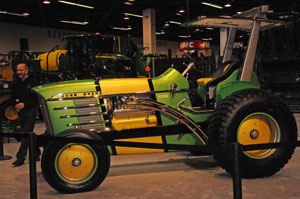 I am attending
I am attending 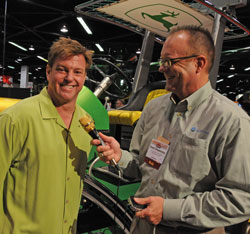 Steve Geick, tactical marketing manager for John Deere, says the John Deere 4020 is one of the most widely used and recognized tractor models ever produced, which made it the perfect tractor for this project. “We wanted a well-known and creative auto designer to work on a John Deere classic and then share this customized tractor with people across the country,” Geick explains. “We couldn’t be more proud to have Chip and his team take our most popular tractor and create something unique and exciting with it.”
Steve Geick, tactical marketing manager for John Deere, says the John Deere 4020 is one of the most widely used and recognized tractor models ever produced, which made it the perfect tractor for this project. “We wanted a well-known and creative auto designer to work on a John Deere classic and then share this customized tractor with people across the country,” Geick explains. “We couldn’t be more proud to have Chip and his team take our most popular tractor and create something unique and exciting with it.”  Superior precision farming software is crucial in order to help growers maximize in-field efficiencies. Ag Leader Technology not only delivers excellent
Superior precision farming software is crucial in order to help growers maximize in-field efficiencies. Ag Leader Technology not only delivers excellent

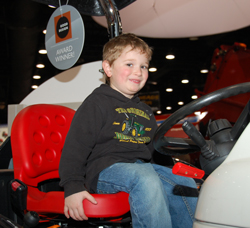 The New Holland Boomer 8N made its debut at the
The New Holland Boomer 8N made its debut at the 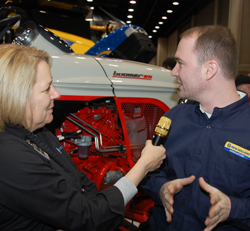 The Boomer 8N is a updated remake of the classic Ford 8N tractor, part of New Holland’s heritage. I talked about the Boomer’s first year with New Holland’s John Hundley. “The history of this project was basically a fusion between the old styling of the Ford 8N with new technology of today,” John said. Many of this first year’s sales have been to collectors or people who have fond memories of the legendary Ford 8N growing up on a farm in the 40s and 50s. “We have some people who are buying this tractor and parking it because they don’t want to use it, but this is a workhorse and we do have people buying it and running it in the field everyday.”
The Boomer 8N is a updated remake of the classic Ford 8N tractor, part of New Holland’s heritage. I talked about the Boomer’s first year with New Holland’s John Hundley. “The history of this project was basically a fusion between the old styling of the Ford 8N with new technology of today,” John said. Many of this first year’s sales have been to collectors or people who have fond memories of the legendary Ford 8N growing up on a farm in the 40s and 50s. “We have some people who are buying this tractor and parking it because they don’t want to use it, but this is a workhorse and we do have people buying it and running it in the field everyday.”

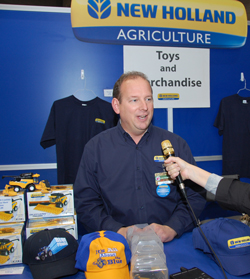 Green farm equipment apparel has gone pretty mainstream in the past several years, but if you see someone sporting a
Green farm equipment apparel has gone pretty mainstream in the past several years, but if you see someone sporting a  I talked with Glenn Brumley who was staffing the New Holland toys and merchandise display at the National Farm Machinery Show about some of the popular items at the big show. “Each year we have a special feature and this year it happens to be a combine in commemoration of the 35th anniversary of our twin rotor combine,” Glenn said. “So that’s been a popular item since every body likes to have something that’s dated from each farm show season.”
I talked with Glenn Brumley who was staffing the New Holland toys and merchandise display at the National Farm Machinery Show about some of the popular items at the big show. “Each year we have a special feature and this year it happens to be a combine in commemoration of the 35th anniversary of our twin rotor combine,” Glenn said. “So that’s been a popular item since every body likes to have something that’s dated from each farm show season.” 
